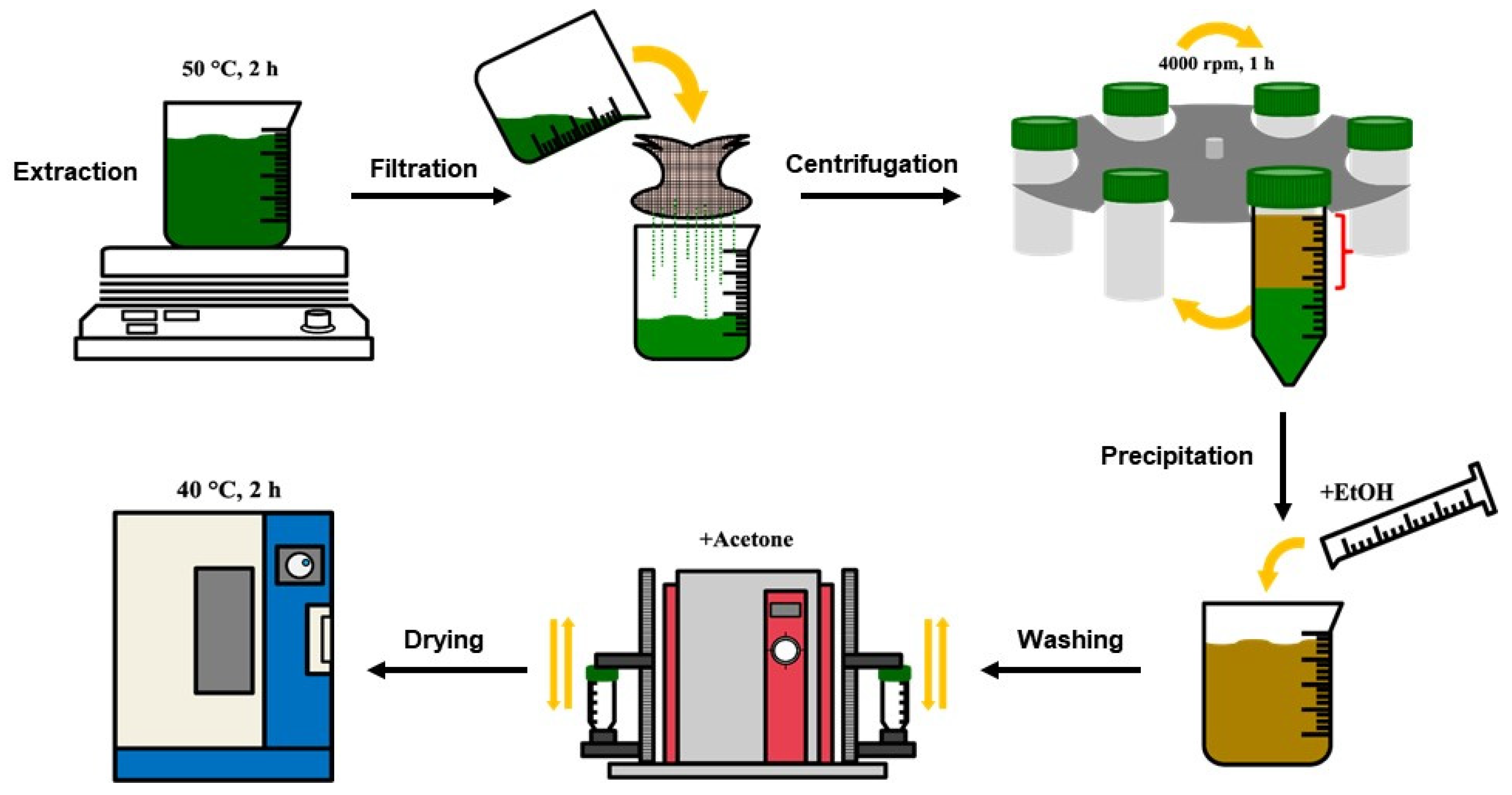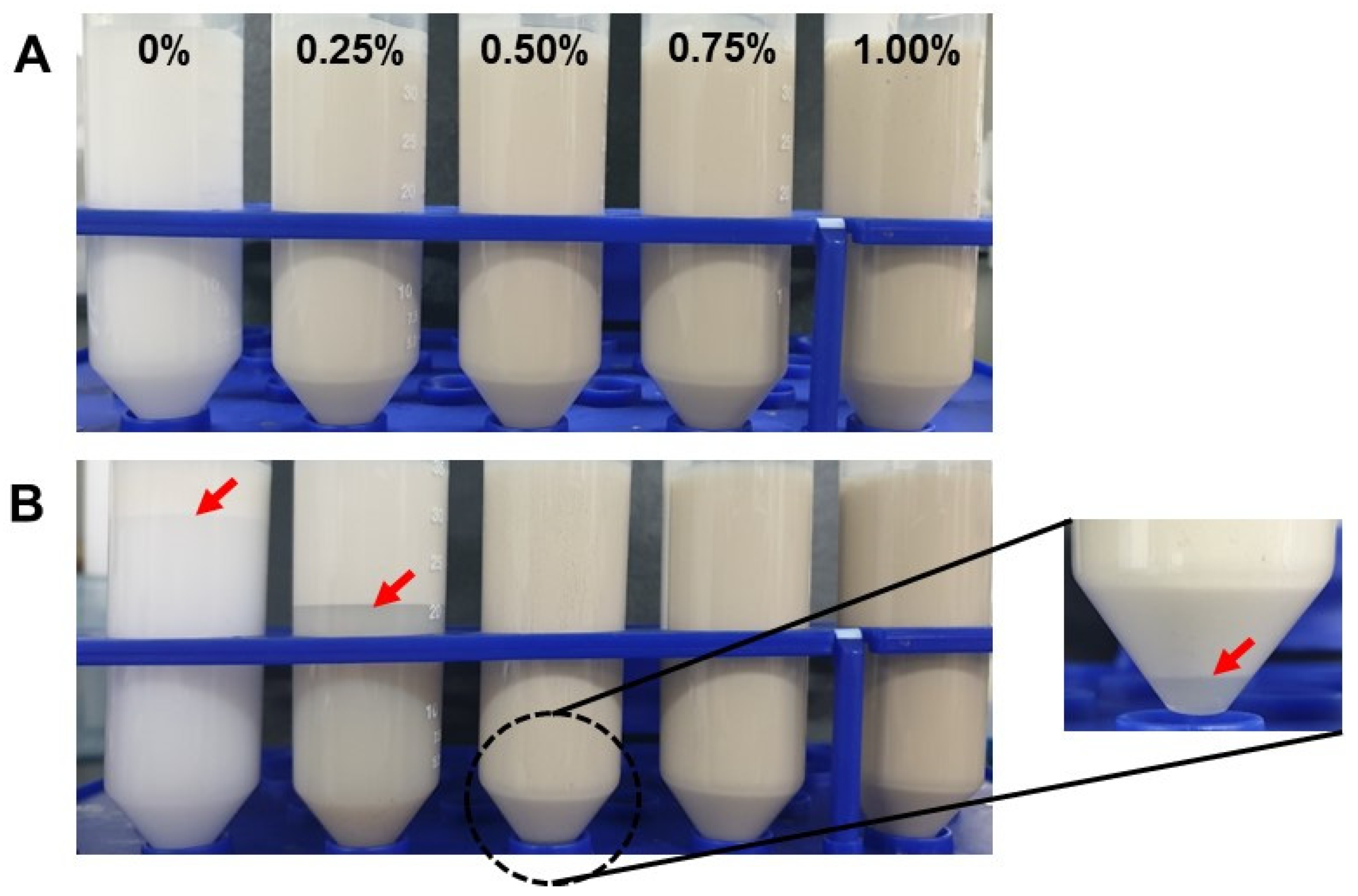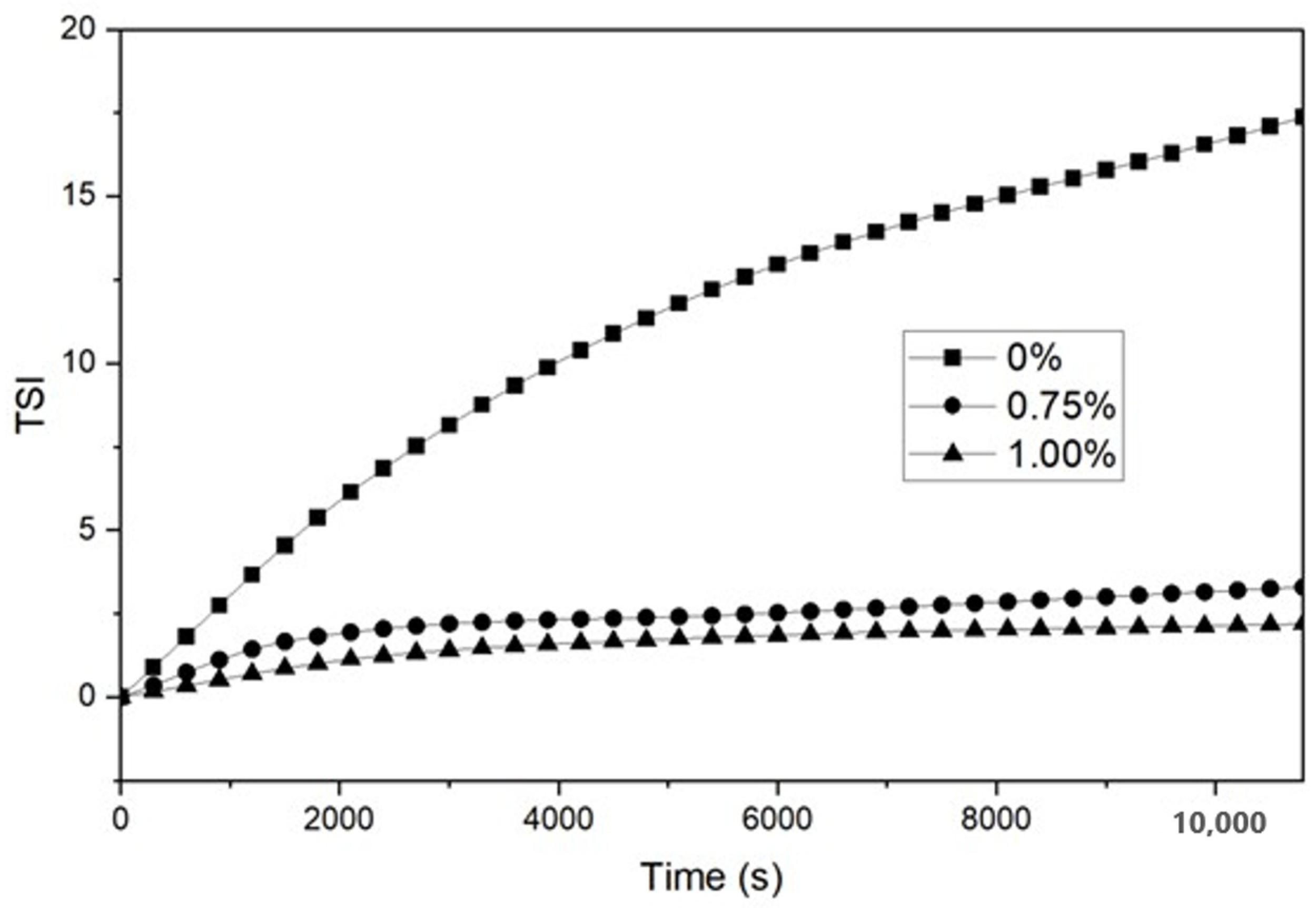Effect of Mucilage Extracted from Corchorus olitorius Leaves on Bovine Serum Albumin (BSA)-Stabilized Oil-in-Water Emulsions
Abstract
1. Introduction
2. Materials and Methods
2.1. Materials
2.2. Extraction of Mucilage
2.3. Confirmation of Mucilage Presence
2.4. Preparation of Oil-in-Water Emulsion
2.5. Characterization of Emulsions
2.5.1. Droplet Size and Zeta Potential of Emulsions
2.5.2. Spectroturbidity of Emulsions
2.5.3. Creaming Stability of Emulsions
2.6. Statistical Analysis
3. Results and Discussion
3.1. Conformation of Mucilage Extracted from Corchorus olitorius L.
3.2. Droplet Size of Emulsions
3.3. Zeta Potential of Emulsions
3.4. Spectroturbidity of Emulsions
3.5. Creaming Stability of Emulsions
4. Conclusions
Author Contributions
Funding
Institutional Review Board Statement
Informed Consent Statement
Data Availability Statement
Conflicts of Interest
References
- McClements, D.J. Food Emulsions: Principles, Practices, and Techniques; CRC Press: Boca Raton, FL, USA, 2004. [Google Scholar]
- Guzey, D.; McClements, D.J. Formation, stability and properties of multilayer emulsions for application in the food industry. Adv. Colloid Interface Sci. 2006, 128, 227–248. [Google Scholar] [CrossRef] [PubMed]
- Lago, A.M.T.; Neves, I.C.O.; Oliveira, N.L.; Botrel, D.A.; Minim, L.A.; de Resende, J.V. Ultrasound-assisted oil-in-water nanoemulsion produced from pereskia aculeata miller mucilage. Ultrason. Sonochem. 2019, 50, 339–353. [Google Scholar] [CrossRef] [PubMed]
- Dickinson, E. Hydrocolloids as emulsifiers and emulsion stabilizers. Food Hydrocoll. 2009, 23, 1473–1482. [Google Scholar] [CrossRef]
- McClellan, S.J.; Franses, E.I. Effect of concentration and denaturation on adsorption and surface tension of bovine serum albumin. Colloids Surf. B Biointerfaces 2003, 28, 63–75. [Google Scholar] [CrossRef]
- Kim, D.-Y.; Shin, W.-S. Roles of fucoidan, an anionic sulfated polysaccharide on bsa-stabilized oil-in-water emulsion. Macromol. Res. 2009, 17, 128–132. [Google Scholar] [CrossRef]
- Kim, D.-Y.; Shin, W.-S.; Hong, W.-S. The unique behaviors of biopolymers, bsa and fucoidan, in a model emulsion system under different ph circumstances. Macromol. Res. 2010, 18, 1103–1108. [Google Scholar] [CrossRef]
- Li, X.; Fang, Y.; Al-Assaf, S.; Phillips, G.O.; Yao, X.; Zhang, Y.; Zhao, M.; Zhang, K.; Jiang, F. Complexation of bovine serum albumin and sugar beet pectin: Structural transitions and phase diagram. Langmuir 2012, 28, 10164–10176. [Google Scholar] [CrossRef]
- Park, K.-Y.; Kim, D.-Y.; Shin, W.-S. Roles of chondroitin sulfate in oil-in-water emulsions formulated using bovine serum albumin. Food Sci. Biotechnol. 2015, 24, 1583–1589. [Google Scholar] [CrossRef]
- Loumerem, M.; Alercia, A. Descriptors for jute (Corchorus olitorius L.). Genet. Resour. Crop Evol. 2016, 63, 1103–1111. [Google Scholar] [CrossRef]
- Choudhary, S.B.; Sharma, H.K.; Anil Kumar, A.; Maruthi, R.; Karmakar, P.G. The genus Corchorus L. (malvaceae) in India: Species distribution and ethnobotany. Genet. Resour. Crop Evol. 2017, 64, 1675–1686. [Google Scholar] [CrossRef]
- Choudhary, S.B.; Sharma, H.K.; Karmakar, P.G.; Kumar, A.A.; Saha, A.R.; Hazra, P.; Mahapatra, B.S. Nutritional profile of cultivated and wild jute (‘corchorus’) species. Aust. J. Crop Sci. 2013, 7, 1973–1982. [Google Scholar]
- Furumoto, T.; Wang, R.; Okazaki, K.; AFM, F.; ALI, M.I.; Kondo, A.; Fukui, H. Antitumor promoters in leaves of jute (corchorus capsularis and corchorus olitorius). Food Sci. Technol. Res. 2002, 8, 239–243. [Google Scholar] [CrossRef]
- Adegoke, A.; Adebayo-Tayo, B. Phytochemical composition and antimicrobial effects of corchorous olitorius leaf extracts on four bacterial isolates. J. Med. Plants Res. 2009, 3, 155–159. [Google Scholar]
- Ramadevi, D.; Ganapaty, S. Antimicrobial activity of Corchous olitorius L. Pharmacol. Online 2011, 2, 1303–1308. [Google Scholar]
- Oboh, G.; Raddatz, H.; Henle, T. Characterization of the antioxidant properties of hydrophilic and lipophilic extracts of jute (Corchorus olitorius) leaf. Int. J. Food Sci. Nutr. 2009, 60, 124–134. [Google Scholar] [CrossRef]
- Kumari, N.; Choudhary, S.B.; Sharma, H.K.; Singh, B.K.; Kumar, A.A. Health-promoting properties of corchorus leaves: A review. J. Herb. Med. 2019, 15, 100240. [Google Scholar] [CrossRef]
- Oh, S.; Kim, D.-Y. Characterization, antioxidant activities, and functional properties of mucilage extracted from corchorus olitorius L. Polymers 2022, 14, 2488. [Google Scholar] [CrossRef]
- Jung, C.-H.; Choi, I.-W.; Kim, S.-R.; Seog, H.-M. Effect of molokhia (Corchorus olitorius) and its mucilage on cholesterol metabolism in high cholesterol fed rats. Korean J. Food Sci. Technol. 2003, 35, 379–385. [Google Scholar]
- Tosif, M.M.; Najda, A.; Bains, A.; Kaushik, R.; Dhull, S.B.; Chawla, P.; Walasek-Janusz, M. A comprehensive review on plant-derived mucilage: Characterization, functional properties, applications, and its utilization for nanocarrier fabrication. Polymers 2021, 13, 1066. [Google Scholar] [CrossRef]
- Brütsch, L.; Stringer, F.J.; Kuster, S.; Windhab, E.J.; Fischer, P. Chia seed mucilage–a vegan thickener: Isolation, tailoring viscoelasticity and rehydration. Food Funct. 2019, 10, 4854–4860. [Google Scholar] [CrossRef]
- Suwan, T.; Muangma, N.; Soponpattarin, B.; Jakkranuhwat, N. Development of mucilage powder from basella rubra and elderly products application. J. Food Process. Preserv. 2022, 46, e15951. [Google Scholar] [CrossRef]
- Yeole, N.; Sandhya, P.; Chaudhari, P.; Bhujbal, P. Evaluation of malva sylvestris and pedalium murex mucilage as suspending agent. Int. J. PharmTech Res. 2010, 2, 385–389. [Google Scholar]
- Olawuyi, I.F.; Lee, W.Y. Structural characterization, functional properties and antioxidant activities of polysaccharide extract obtained from okra leaves (Abelmoschus esculentus). Food Chem. 2021, 354, 129437. [Google Scholar] [CrossRef] [PubMed]
- Pereira, G.A.; Silva, E.K.; Araujo, N.M.P.; Arruda, H.S.; Meireles, M.A.A.; Pastore, G.M. Mutamba seed mucilage as a novel emulsifier: Stabilization mechanisms, kinetic stability and volatile compounds retention. Food Hydrocoll. 2019, 97, 105190. [Google Scholar] [CrossRef]
- Capitani, M.I.; Nolasco, S.M.; Tomás, M.C. Stability of oil-in-water (o/w) emulsions with chia (Salvia hispanica L.) mucilage. Food Hydrocoll. 2016, 61, 537–546. [Google Scholar] [CrossRef]
- Noorlaila, A.; Siti Aziah, A.; Asmeda, R.; Norizzah, A. Emulsifying properties of extracted okra (Abelmoschus esculentus L.) mucilage of different maturity index and its application in coconut milk emulsion. Int. Food Res. J. 2015, 22, 782–787. [Google Scholar]
- Choudhary, P.D.; Pawar, H.A. Recently investigated natural gums and mucilages as pharmaceutical excipients: An overview. J. Pharm. 2014, 2014, 204849. [Google Scholar] [CrossRef]
- Carbone, C.; Musumeci, T.; Lauro, M.; Puglisi, G. Eco-friendly aqueous core surface-modified nanocapsules. Colloids Surf. B Biointerfaces 2015, 125, 190–196. [Google Scholar] [CrossRef]
- Zhao, L.; Zhang, S.; Uluko, H.; Liu, L.; Lu, J.; Xue, H.; Kong, F.; Lv, J. Effect of ultrasound pretreatment on rennet-induced coagulation properties of goat’s milk. Food Chem. 2014, 165, 167–174. [Google Scholar] [CrossRef]
- Sivakumar, M.; Tang, S.Y.; Tan, K.W. Cavitation technology–a greener processing technique for the generation of pharmaceutical nanoemulsions. Ultrason. Sonochem. 2014, 21, 2069–2083. [Google Scholar] [CrossRef]
- Carpenter, J.; Saharan, V.K. Ultrasonic assisted formation and stability of mustard oil in water nanoemulsion: Effect of process parameters and their optimization. Ultrason. Sonochem. 2017, 35, 422–430. [Google Scholar] [CrossRef]
- Soleimanpour, M.; Koocheki, A.; Kadkhodaee, R. Effect of lepidium perfoliatum seed gum addition on whey protein concentrate stabilized emulsions stored at cold and ambient temperature. Food Hydrocoll. 2013, 30, 292–301. [Google Scholar] [CrossRef]
- Khalloufi, S.; Alexander, M.; Goff, H.D.; Corredig, M. Physicochemical properties of whey protein isolate stabilized oil-in-water emulsions when mixed with flaxseed gum at neutral ph. Food Res. Int. 2008, 41, 964–972. [Google Scholar] [CrossRef]
- Capitani, M.I.; Sandoval-Peraza, M.; Chel-Guerrero, L.A.; Betancur-Ancona, D.A.; Nolasco, S.M.; Tomás, M.C. Functional chia oil-in-water emulsions stabilized with chia mucilage and sodium caseinate. J. Am. Oil Chem. Soc. 2018, 95, 1213–1221. [Google Scholar] [CrossRef]
- Peters, T., Jr. Serum albumin. Adv. Protein Chem. 1985, 37, 161–245. [Google Scholar]
- Ru, Q.; Wang, Y.; Lee, J.; Ding, Y.; Huang, Q. Turbidity and rheological properties of bovine serum albumin/pectin coacervates: Effect of salt concentration and initial protein/polysaccharide ratio. Carbohydr. Polym. 2012, 88, 838–846. [Google Scholar] [CrossRef]
- Ye, A.; Hemar, Y.; Singh, H. Enhancement of coalescence by xanthan addition to oil-in-water emulsions formed with extensively hydrolysed whey proteins. Food Hydrocoll. 2004, 18, 737–746. [Google Scholar] [CrossRef]
- Guiotto, E.N.; Capitani, M.I.; Nolasco, S.M.; Tomás, M.C. Stability of oil-in-water emulsions with sunflower (Helianthus annuus L.) and chia (Salvia hispanica L.) by-products. J. Am. Oil Chem. Soc. 2016, 93, 133–143. [Google Scholar] [CrossRef]
- Vegi, G.M.N.; Sistla, R.; Srinivasan, P.; Beedu, S.R.; Khar, R.K.; Diwan, P.V. Emulsifying properties of gum kondagogu (Cochlospermum gossypium), a natural biopolymer. J. Sci. Food Agric. 2009, 89, 1271–1276. [Google Scholar] [CrossRef]
- Timilsena, Y.P.; Adhikari, R.; Kasapis, S.; Adhikari, B. Molecular and functional characteristics of purified gum from australian chia seeds. Carbohydr. Polym. 2016, 136, 128–136. [Google Scholar] [CrossRef]
- Krstonošić, V.; Dokić, L.; Nikolić, I.; Milanović, M. Influence of xanthan gum on oil-in-water emulsion characteristics stabilized by osa starch. Food Hydrocoll. 2015, 45, 9–17. [Google Scholar] [CrossRef]
- Hayati, I.N.; Man, Y.B.C.; Tan, C.P.; Aini, I.N. Droplet characterization and stability of soybean oil/palm kernel olein o/w emulsions with the presence of selected polysaccharides. Food Hydrocoll. 2009, 23, 233–243. [Google Scholar] [CrossRef]
- Fioramonti, S.A.; Martinez, M.J.; Pilosof, A.M.; Rubiolo, A.C.; Santiago, L.G. Multilayer emulsions as a strategy for linseed oil microencapsulation: Effect of ph and alginate concentration. Food Hydrocoll. 2015, 43, 8–17. [Google Scholar] [CrossRef]






| Mucilage (%) | Storage Time (Days) | ||||
|---|---|---|---|---|---|
| 0 | 1 | 2 | 4 | 7 | |
| 0 | 297.00 ± 15.7 0 bC | 336.63 ± 87.40 bB | 273.56 ± 22.34 bC | 333.57 ± 15.00 bC | 448.03 ± 5.36 aB |
| 0.25 | 538.37 ± 55.18 aB | 266.80 ± 3.87 cB | 277.77 ± 16.40 cC | 347.77 ± 20.90 bC | 295.90 ± 44.49 bcD |
| 0.50 | 607.10 ± 60.75 aAB | 597.60 ± 36.25 aA | 657.77 ± 17.42 aA | 497.77 ± 24.16 bB | 368.37 ± 38.10 cC |
| 0.75 | 580.33 ± 22.25 abAB | 603.57 ± 33.19 abA | 633.73 ± 18.49 aAB | 567.07 ± 39.64 bA | 552.60 ± 22.87 bA |
| 1.00 | 659.73 ± 68.69 aA | 626.60 ± 19.24 abA | 615.03 ± 31.28 abB | 591.70 ± 23.62 abA | 573.33 ± 30.13 bA |
| Mucilage (%) | Storage Time (Days) | ||||
|---|---|---|---|---|---|
| 0 | 1 | 2 | 4 | 7 | |
| 0 | −41.43 ± 0.35 bA | −40.26 ± 0.23 bA | −37.33 ± 1.35 aA | −42.47 ± 1.97 bA | −48.80 ± 2.48 cB |
| 0.25 | −44.87 ± 1.03 bB | −44.77 ± 0.32 bB | −45.50 ± 0.92 bB | −42.17 ± 1.47 aA | −43.83 ± 1.47 abA |
| 0.50 | −44.33 ± 2.40 abB | −44.87 ± 0.61 bB | −45.27 ± 0.96 bB | −41.80 ± 1.55 aA | −42.80 ± 0.78 abA |
| 0.75 | −44.23 ± 0.21 abB | −44.80 ± 1.40 abB | −46.40 ± 2.01 bB | −42.43 ± 0.97 aA | −43.47 ± 1.86 aA |
| 1.00 | −43.13 ± 0.80 aAB | −44.80 ± 0.75 abB | −46.13 ± 0.38 bB | −43.50 ± 1.15 aA | −43.83 ± 1.60 aA |
Disclaimer/Publisher’s Note: The statements, opinions and data contained in all publications are solely those of the individual author(s) and contributor(s) and not of MDPI and/or the editor(s). MDPI and/or the editor(s) disclaim responsibility for any injury to people or property resulting from any ideas, methods, instructions or products referred to in the content. |
© 2022 by the authors. Licensee MDPI, Basel, Switzerland. This article is an open access article distributed under the terms and conditions of the Creative Commons Attribution (CC BY) license (https://creativecommons.org/licenses/by/4.0/).
Share and Cite
Kim, D.-Y.; Kim, H. Effect of Mucilage Extracted from Corchorus olitorius Leaves on Bovine Serum Albumin (BSA)-Stabilized Oil-in-Water Emulsions. Polymers 2023, 15, 113. https://doi.org/10.3390/polym15010113
Kim D-Y, Kim H. Effect of Mucilage Extracted from Corchorus olitorius Leaves on Bovine Serum Albumin (BSA)-Stabilized Oil-in-Water Emulsions. Polymers. 2023; 15(1):113. https://doi.org/10.3390/polym15010113
Chicago/Turabian StyleKim, Do-Yeong, and Hyunsu Kim. 2023. "Effect of Mucilage Extracted from Corchorus olitorius Leaves on Bovine Serum Albumin (BSA)-Stabilized Oil-in-Water Emulsions" Polymers 15, no. 1: 113. https://doi.org/10.3390/polym15010113
APA StyleKim, D.-Y., & Kim, H. (2023). Effect of Mucilage Extracted from Corchorus olitorius Leaves on Bovine Serum Albumin (BSA)-Stabilized Oil-in-Water Emulsions. Polymers, 15(1), 113. https://doi.org/10.3390/polym15010113






